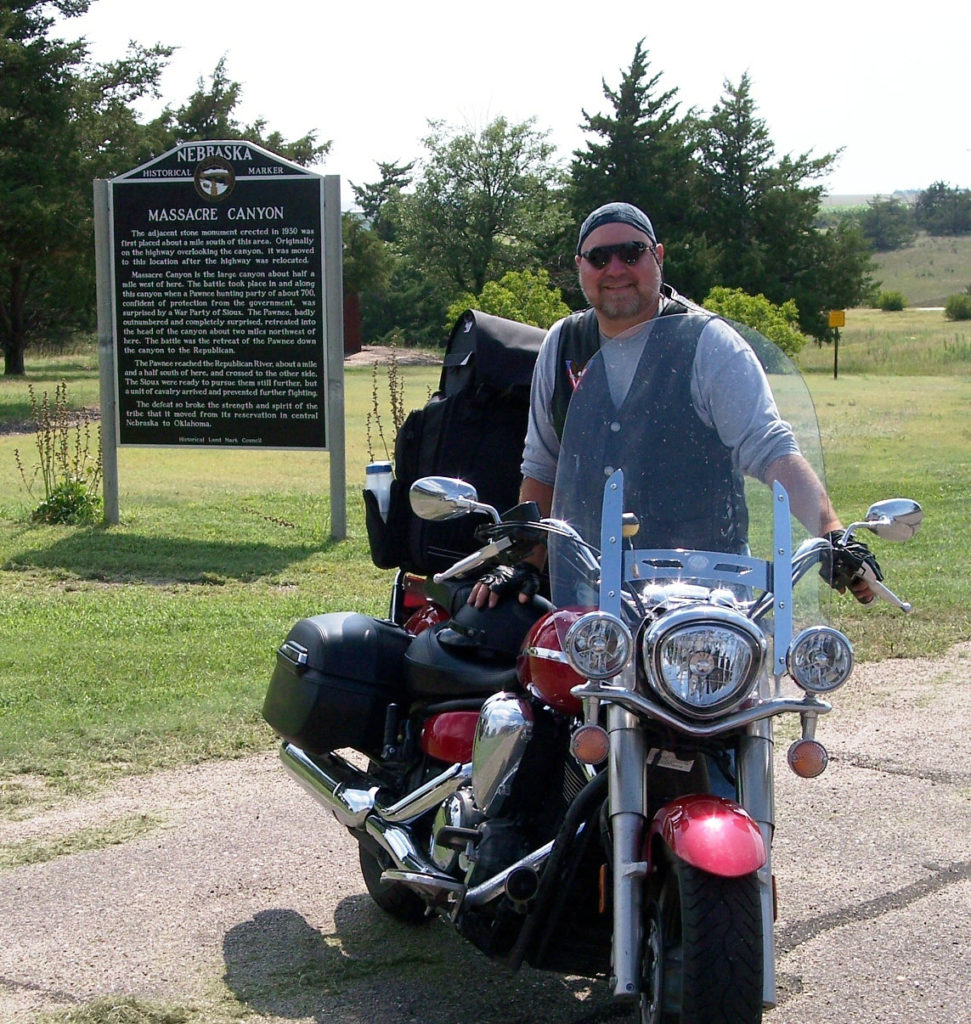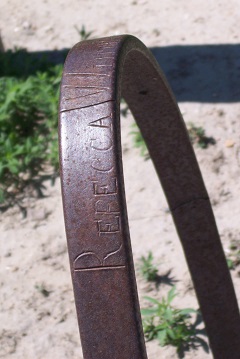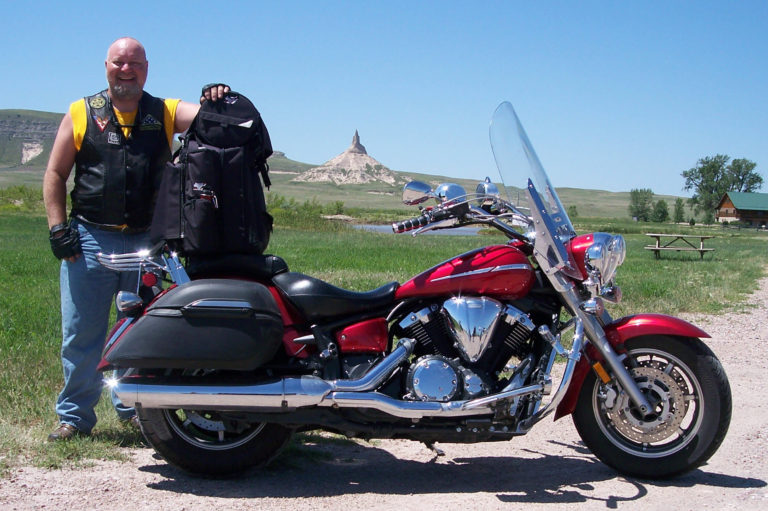
Butch Springgate stands with his motorcycle in front of the Massacre Canyon Historical Marker near Trenton in Hitchcock County, Nebraska. This is one of over 500 Nebraska Historical Markers that Springgate has visited. Photo courtesy of Springgate.
Butch Springgate is the grand champion of Nebraska’s biggest scavenger hunt. If you’ve driven on a Nebraska highway, you’ve even played it. But while you might have passed one or two of Nebraska’s historic markers or even stopped by a couple dozen, Springgate has you beat. He’s been to more than 500. On a motorcycle.
“We like to say that the motorcycle is closer to the horse and buggy days because you aren’t in an air-conditioned car, and you get to travel the back roads,” Springgate said. “So we make a point of doing that.” Springgate, who lives in Fremont, has spent the last eight years visiting historical markers on his Yamaha motorcycle. Sometimes he brings along friends, but many he’s visited alone. The only markers he hasn’t seen are the handful that local organizers and the NSHS have put up since last summer. He’ll visit those this summer and fall. Springgate’s first marker was the Massacre Canyon marker near Trenton in Hitchcock County, which he visited in late 2008.
Springgate is a Quality Control Technician for 3M in Fremont, so using long weekends and – at the longest – nine-day trips, his quest has been continuous except for a year he took off because of shoulder surgery. He has logged 20,000 miles of riding, and his longest historical marker ride was 1,500 miles. His dedication to record-keeping and staying organized has made his summer-centered hobby last all year long. “My winter activity is putting everything into books and getting things updated,” he said.
Springgate meticulously documents all of his rides. He has a growing collection of binders with photos of every single marker, along with where and when they were taken. He also has a map with black dots for the locations of every marker and silver dots for every marker he’s visited. But the photos in the binders don’t show the adventures that lead to a successful marker find.
One of the worst roads Springgate has ever traveled was on the way to see the Grand Duke Alexis marker in Hayes County. “It’s two and a half miles of no maintenance roads. I’m going one mile per hour, holding my feet out and bouncing,” Springgate said. “So we’re riding through baking flour-type dirt eight inches deep. It moves like water waves and covers us. Then, covered up by this dirt are rocks a little smaller than a volleyball. We made it to the marker, and when we got back, I said, ‘I’ve never done this before, but I am kissing the pavement.’ And we did. We actually kissed the pavement.” But Springgate assures that the ride to a historical marker is worth it – no matter what. “I was glad we got to it, though,” he said. “Nice rolling hills and farmland. No traffic, very quiet.”
Other adventures include a snapped clutch cable, seeking shelter from a tornado under the tables of a Crawford Pizza Hut, and a muddy wipe out on a lonely road in Webster County.
During the latter, Springgate was on a solo journey and searching for a historical marker at a cemetery. “The road was dry and arid,” Springgate said. “I was looking up trying to see if the cemetery was on the next hill, and I wasn’t looking at the road, and then suddenly I hit wet clay.” The bike went sideways, and both Springgate and his motorcycle lay in the mud. “I couldn’t lift the motorcycle, so I was stuck,” he said. He had no cell phone reception, so he walked two miles to the nearest farm. No one was home. So he walked two more miles. No one was home there either. But just as he turned away from the door, a pickup pulled in the driveway – where it immediately stopped.
“I was in all-black leather with a do-rag and just covered in mud,” Springgate said. “I took off my jacket and helmet and put them in a little pile and walked out to the pickup, which had just stopped in the driveway. I explained what had happened and said ‘So I kind of have a problem.’ The farmer looked me from head to toe and said, ‘Yes, you do, son.’” The farmer and his teenage sons got Springgate’s bike unstuck with the four-wheeler, and then even accompanied him to see the marker. The farmer said he hadn’t even known it was there. He was also impressed with Springgate’s navigational skills. “‘This county has been in a drought for two years and somehow, son, you found the only mud puddle in the county,’ he said to me,” Springgate relates. “After feeling mad, embarrassed, and covered in mud, his humor made getting back on the road a lot less stressful.” He still has a mud spot on his gear that he couldn’t wash out. “That clay is real permanent,” Springgate said.
But the Webster County farmer isn’t the only one who doesn’t know about the history in his backyard. Springgate hopes to use his hobby to encourage others to get out and explore Nebraska’s history. “To anyone who might hear my story, I would impress to them if at all possible to visit the markers and not just read about them on their phones,” Springgate said. “The Nebraska history comes to life when you are reading the marker story as you are standing on the actual location of the historical event.” His best example is the Republican River Flood of 1935 marker in Furnas County. “Reading the marker narrative and looking behind the marker at the horizon, then turning around seeing the opposite horizon distance, really gives you scale of how vast and deep the flood was where you are standing. Awesome experience,” Springgate said.
Springgate said one of the markers that touched him the most is the Rebecca Winters marker in Scottsbluff County. Winters died from cholera en route to Utah in 1852. Lacking wood or stone, a family friend took the rim of a wagon wheel and etched her name on it. Visitors can still see the wagon rim tombstone today. “I can’t imagine leaving your loved one like that,” he said. “These people were in the middle of nothing.”
Springgate doesn’t just take a photo and leave. He carries a knife to clear away weeds and debris if a marker needs it. “Then we read the marker, thank the servicemen if that’s applicable, and if it’s a cemetery, we say a little prayer. We try to be as respectful as possible,” he says.
Springgate’s motorcycle is not just connected to his love of his history. It’s also connected to a deep sense of patriotism. “I had a full Uncle Sam suit – I even cut my beard like Uncle Sam’s – that I wore with American flags on my bike,” Springgate said. “People in the parks would stop what they were doing to put their hands over their hearts. They were even saluting me. I was so humbled at that. I just get chills even talking about it now.”
He is also a member of the Patriot Guard Riders. “You wear a patch on your upper left of your jacket, and one time a mother comes up to me and thanks me, and I’m like ‘No, thank you for what your son does and what you and your family do.’” Springgate said. “As part of the junior high and high school crowd, I was one of the worst ones for saying, ‘The war is terrible and the military is terrible.’ As I got older, I thought I needed to make up for it so I joined the Patriot Guard. I was never a protestor, but my mind was cruel. I see these young people now and I’m inspired by them.”

This wagon wheel monument marks the grave of Rebecca Winters. Winters died on August 15, 1852 when she and her family were on their way to Utah in their covered wagon. Her grave is also marked with a Nebraska Historical Marker.

Butch Springgate stands with his motorcycle in front of Chimney Rock. Visiting the historic landmark was part of his journey to visit over 500 Nebraska Historical Markers.
Springgate’s interest in meeting people and hearing their stories has led to a strict no-GPS policy. He and his friends rely on maps and local guides. “If I can’t find one, I check in at the local gas station. They seem to know everything,” Springgate said. “When I bring in the maps, a whole group tries to help. People ask me, ‘Why don’t you just use GPS?’ and I tell them, ‘I wouldn’t have met you if I used GPS.’ We want to do it low-tech and meet people.” Springgate said he often seeks out police officers, firefighters, postal workers, and sanitation workers to help him find a marker if it’s missing.
Springgate has also been responsible for finding a marker that was later restored to public view. The O.K. Store marker in Hall County was moved because of State Fair Park construction. When Springgate tried to find it and failed, employees spent three weeks trying to locate it. When they did, they called him and he came back out to take a photo. They’ve since re-installed the marker. “They said they were embarrassed it had gotten shuffled to storage,” Springgate said. “They said they would put it up because of me, and later they called and said they had. I just thought, ‘Wow, I made a difference.’”
Finding moved or missing markers does happen occasionally. Nebraska’s historical marker program is the result of several programs working together. The first state-sponsored Nebraska historical marker was dedicated at Fort Calhoun on May 21, 1961. Other markers had been installed to commemorate the Oregon Trail or other local historical events and places. However, the Nebraska legislature decided in 1957 that recognizing Nebraska’s historic sites uniformly and accurately was important for both historical record and tourism, passing a bill the evolved into the program that exists today.
Local initiatives identify, create, and fund the markers, History Nebraska edits and works with a foundry to make them, and the Nebraska Department of Roads installs them. The markers are made of white or silver text on a dark blue background with the seal of the State of Nebraska and the words “Nebraska Historical Marker.” They range from large signs with two posts to one-post signs to signs that lay nearly flat on a pedestal. Their costs range from $1,750 – $5,100 depending on their size.
“The majority are in really good shape,” Springgate said. “It makes me very disappointed when I see bullet holes. There was gang graffiti on one in Douglas County and that one wasn’t six months old. But some are just gorgeous the way they take care of them. Some have spotlights and flowers and flags or white lattice fences.” Springgate’s bike is in the shop this spring so that it’s ready for more marker hunting this summer. “The group of guys I ride with, we always talk about how ‘It’s the journey, not the destination.’” Springgate said. “Me, I like to have a destination. But my destination doesn’t have to be set in stone.”
He’s right. His destinations are set in aluminum.




